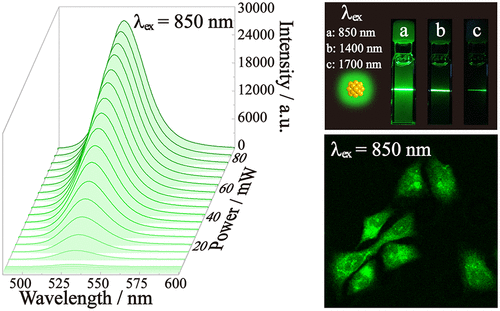当前位置:
X-MOL 学术
›
ACS Appl. Mater. Interfaces
›
论文详情
Our official English website, www.x-mol.net, welcomes your
feedback! (Note: you will need to create a separate account there.)
Excellent Multiphoton Excitation Fluorescence with Large Multiphoton Absorption Cross Sections of Arginine-Modified Gold Nanoclusters for Bioimaging
ACS Applied Materials & Interfaces ( IF 8.3 ) Pub Date : 2022-01-05 , DOI: 10.1021/acsami.1c16324 Zhongran Wei 1 , Yatao Pan 2 , Guangjing Hou 2 , Xia Ran 2 , Zhen Chi 2 , Yulu He 2 , Yanmin Kuang 2 , Xiaojuan Wang 2 , Renming Liu 2 , Lijun Guo 1
ACS Applied Materials & Interfaces ( IF 8.3 ) Pub Date : 2022-01-05 , DOI: 10.1021/acsami.1c16324 Zhongran Wei 1 , Yatao Pan 2 , Guangjing Hou 2 , Xia Ran 2 , Zhen Chi 2 , Yulu He 2 , Yanmin Kuang 2 , Xiaojuan Wang 2 , Renming Liu 2 , Lijun Guo 1
Affiliation

|
Fluorescent gold nanoclusters (Au NCs) with excellent one-photon and multiphoton properties have been demonstrated as promising candidates in many application fields. However, small multiphoton absorption (MPA) cross sections and weak multiphoton excitation (MPE) fluorescence impede their practical applications under near-infrared (NIR) excitation for biological imaging. Here, we report the regulated one-photon and multiphoton properties and mechanisms of arginine-stabilized 6-aza-2-thiothymine Au NCs (Arg/ATT-Au NCs) and the applications for MPE fluorescence imaging. The introduction of arginine into the capping layer of ATT-Au NCs significantly modifies the electronic structure, the absorption cross sections, and the relaxation dynamics of the lowest excited state, drastically reducing the nonradiative relaxation, suppressing the blinking, and greatly enhancing the fluorescence. Besides the improved one-photon properties, Arg/ATT-Au NCs demonstrate remarkable MPE fluorescence with a large MPA cross section. The two-photon (λex = 850 nm), three-photon (λex = 1400 nm), and four-photon (λex = 1700 nm) absorption cross sections have been determined to be 6.1 × 10–47 cm4 s1 photon–1, 1.5 × 10–78 cm6 s2 photon–2, and 5.5 × 10–108 cm8 s3 photon–3, respectively, much higher than those of conventional organic compounds and previously reported Au NCs. Moreover, Arg/ATT-Au NCs have been successfully applied in two-photon and three-photon excitation fluorescence imaging of living cells with NIR excitation. The manifold advantages of small size, high quantum yield, suppressed blinking, good photostability and cytocompatibility, large MPA cross sections, and excellent MPE fluorescence imaging performances make fluorescent Arg/ATT-Au NCs a great candidate of imaging probes with vis–NIR excitation.
中文翻译:

用于生物成像的精氨酸修饰金纳米团簇具有大多光子吸收截面的出色多光子激发荧光
具有优异的单光子和多光子特性的荧光金纳米团簇(Au NCs)已被证明是许多应用领域的有前途的候选者。然而,小的多光子吸收(MPA)截面和弱多光子激发(MPE)荧光阻碍了它们在近红外(NIR)激发下用于生物成像的实际应用。在这里,我们报告了精氨酸稳定的 6-aza-2-thiothymine Au NCs (Arg/ATT-Au NCs) 的调节单光子和多光子特性和机制以及在 MPE 荧光成像中的应用。将精氨酸引入 ATT-Au NCs 的覆盖层显着改变了电子结构、吸收截面和最低激发态的弛豫动力学,大大降低了非辐射弛豫,抑制了闪烁,并大大增强荧光。除了改进的单光子特性外,Arg/ATT-Au NCs 还表现出显着的 MPE 荧光和大的 MPA 横截面。双光子(λex = 850 nm)、三光子 (λ ex = 1400 nm) 和四光子 (λ ex = 1700 nm) 吸收截面已确定为 6.1 × 10 –47 cm 4 s 1 photon –1 , 1.5 × 10 –78 cm 6 s 2光子–2和 5.5 × 10 –108 cm 8 s 3光子–3,分别远高于常规有机化合物和先前报道的Au NCs。此外,Arg/ATT-Au NCs 已成功应用于具有 NIR 激发的活细胞的双光子和三光子激发荧光成像。小尺寸、高量子产率、抑制闪烁、良好的光稳定性和细胞相容性、大 MPA 横截面以及出色的 MPE 荧光成像性能等诸多优点使荧光 Arg/ATT-Au NCs 成为具有 vis-NIR 激发的成像探针的理想选择。
更新日期:2022-01-19
中文翻译:

用于生物成像的精氨酸修饰金纳米团簇具有大多光子吸收截面的出色多光子激发荧光
具有优异的单光子和多光子特性的荧光金纳米团簇(Au NCs)已被证明是许多应用领域的有前途的候选者。然而,小的多光子吸收(MPA)截面和弱多光子激发(MPE)荧光阻碍了它们在近红外(NIR)激发下用于生物成像的实际应用。在这里,我们报告了精氨酸稳定的 6-aza-2-thiothymine Au NCs (Arg/ATT-Au NCs) 的调节单光子和多光子特性和机制以及在 MPE 荧光成像中的应用。将精氨酸引入 ATT-Au NCs 的覆盖层显着改变了电子结构、吸收截面和最低激发态的弛豫动力学,大大降低了非辐射弛豫,抑制了闪烁,并大大增强荧光。除了改进的单光子特性外,Arg/ATT-Au NCs 还表现出显着的 MPE 荧光和大的 MPA 横截面。双光子(λex = 850 nm)、三光子 (λ ex = 1400 nm) 和四光子 (λ ex = 1700 nm) 吸收截面已确定为 6.1 × 10 –47 cm 4 s 1 photon –1 , 1.5 × 10 –78 cm 6 s 2光子–2和 5.5 × 10 –108 cm 8 s 3光子–3,分别远高于常规有机化合物和先前报道的Au NCs。此外,Arg/ATT-Au NCs 已成功应用于具有 NIR 激发的活细胞的双光子和三光子激发荧光成像。小尺寸、高量子产率、抑制闪烁、良好的光稳定性和细胞相容性、大 MPA 横截面以及出色的 MPE 荧光成像性能等诸多优点使荧光 Arg/ATT-Au NCs 成为具有 vis-NIR 激发的成像探针的理想选择。































 京公网安备 11010802027423号
京公网安备 11010802027423号